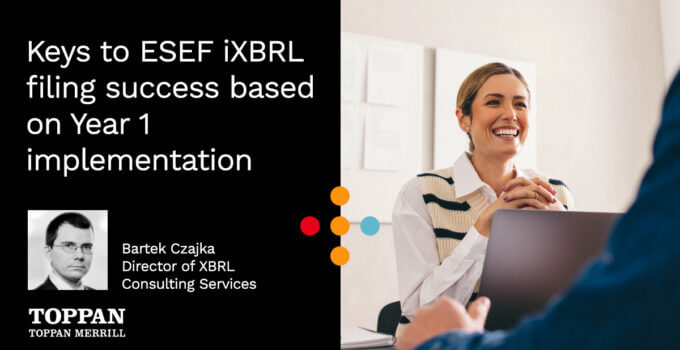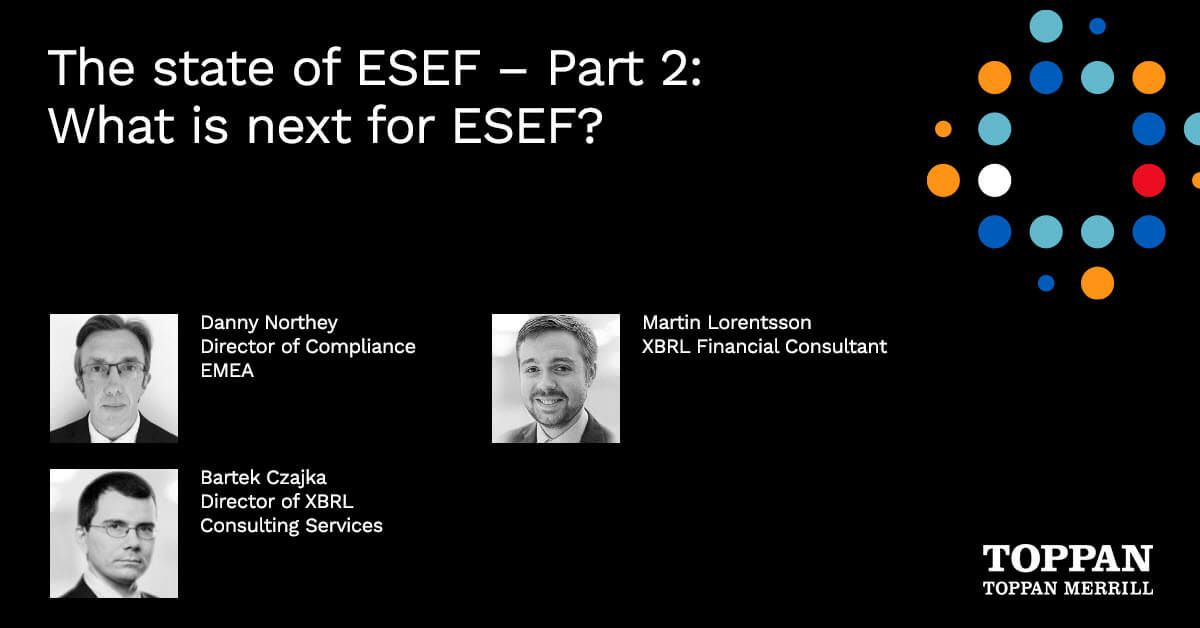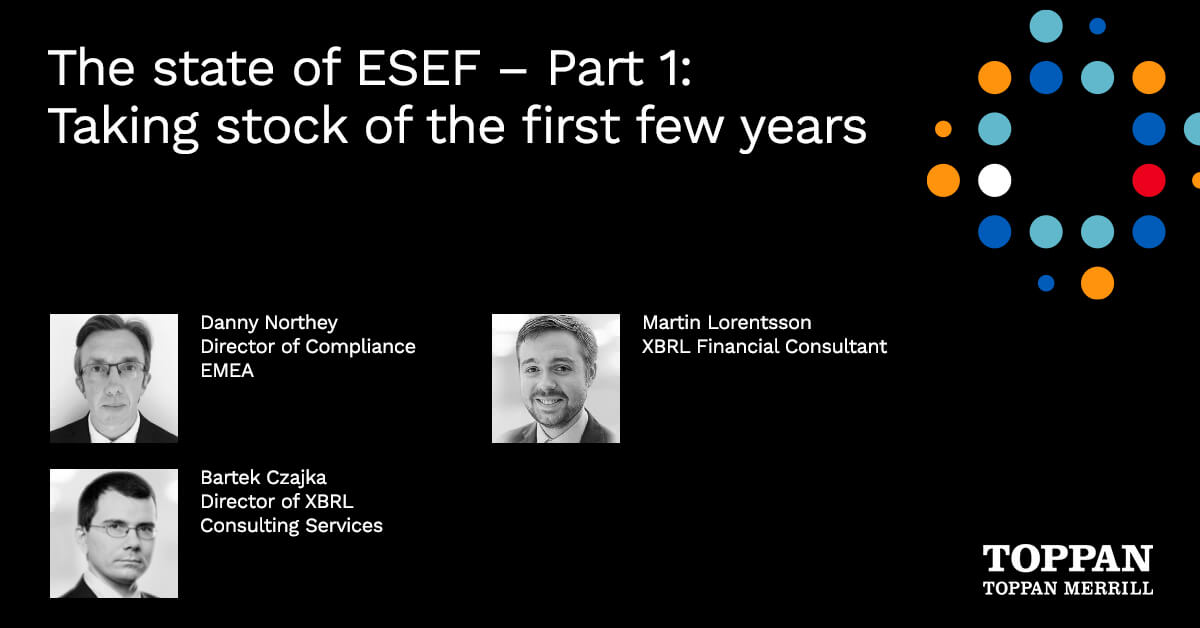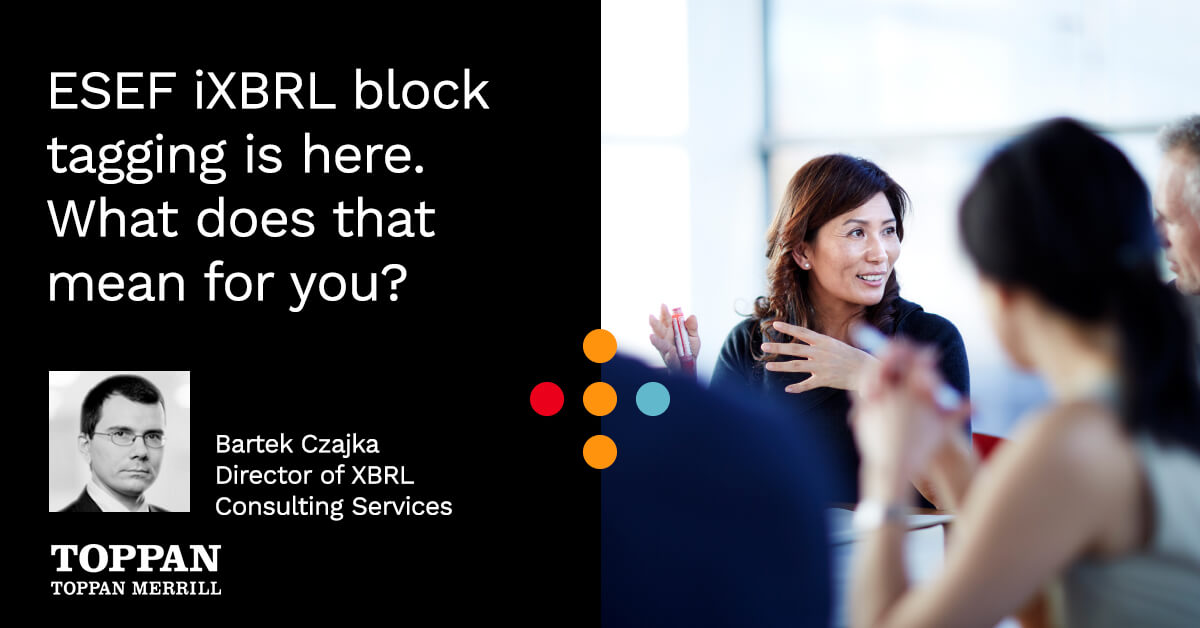After years of buildup – and pandemic delays – the vast majority of issuers have now implemented the ESEF iXBRL filing standard. I recently had the opportunity to be a part of a webinar series hosted by Accountancy Europe that focused on success stories and learnings from Year 1 of ESEF implementation.
The first part of the series featured a panel discussion including myself and experts from Ernst & Young Italy and Deloitte Luxembourg. As moderator Ronald van Langen, XBRL leader within KPMG Netherlands and also a member of Accountancy Europe’s ESEF Task Force, summed it up, “It wasn’t always easy, but implementation of ESEF was successful.”
Having worked with countless Toppan Merrill clients as they navigated Year 1 implementation, I shared my perspective on keys to success in ESEF filing – and a look at the challenges issuers need to be preparing for ahead of the 2022 filing.
Breaking success into two key phases
Thinking about my experiences with successful (and less successful) ESEF filings, I immediately break things down into two key phases:
- Preparation phase
- Execution phase
Make no mistake: Both are equally important. I’ve seen most attention land on the execution phase, but you will not execute well if you have not planned it out before.
Each of these phases can be further broken down into a few key steps or best practices:
Preparation phase – best practices
- Establish a plan and timeline that works for all parties: The first thing you need to do is establish a timeline that gives all involved parties the time necessary for an accurate, complete and on-time filing. This timeline needs to work for you, your auditor, your service provider, your design agency (if you’re using one) and anyone else involved. And make sure this planning includes contingency plans. Delays are common and things can go wrong, even with great planning, so have a plan for when things don’t go perfectly.
- Communicate with the entire team from the outset: Designing a plan is not enough – you need to communicate clearly and continuously with all parties. I have seen cases where the plan was great on paper, but was communicated too late – once the process had already begun – and ultimately resulted in frustrations and delays. Moreover, you should not make any assumptions about the other parties’ needs or timelines. Rather, discuss needs and timelines clearly and continuously before and throughout the process.
- Take the time now to prepare for 2023: Finally in this preparation phase, do prepare for next year. Yes, we know there will be changes and additions that will impact your 2022 filing, but you can (and should) use your 2021 financials to test things out. Conduct a dry run to test your block tagging for next year. And make sure to discuss your upcoming XBRL tagging with your auditors, as well – this will save you a lot of time during the busy season when timelines are very short.
Execution phase – best practices
- Communication is essential: At the risk of sounding like a broken record, communication is essential throughout the entire process – from preparation through execution. Thinking about the most successful project that I was involved in this year, I immediately recall the constant, open and honest communication between all the parties – in particular, the issuer, the service provider (the people that do the XBRL tagging) and the auditor. Poor communication will lead to delays and other issues at the end of the line, when timelines are squeezed and pressure is sky-high. For example, if you don’t talk to your auditor until the end of the process, you’ll end up with a glut of questions that will delay your filing. Equally, if you only talk to your auditor – and don’t communicate with your service provider – you will likely end up with delays on the back end as the service provider works to address tagging matters and other issues that perpetuated throughout the filing.
- Expertise is essential to ensuring correct XBRL tag selection: There are many, many technologies out there that can do your XBRL tagging. Some of them even promise to do it all for you. As I have said many times before, there is no single technology that will get the XBRL tagging 100% right. You need human expertise on your side – from your internal team, your service provider, or both – to ensure that your tagging is 100% correct and will pass through the validations. And that accuracy isn’t merely a matter of compliance — it is critical to ensuring your XBRL tells your company story the way you intend.
- Validate, validate, validate: My final point in the execution phase is that every issuer should be using the readily available tools to validate their XBRL filings prior to submission. In fact, I tell our clients they should be validating every version that they produce. This ongoing validation helps them avoid nasty surprises at the end – when you uncover some serious validation errors that you’re not sure how to fix, and the filing date is fast approaching. As I mentioned, there are lots of validation tools available, but the evidence is clear that not all of them will provide the same quality of results. While the XBRL tagging errors are typically quite easy to identify, there are tricky parts – like validation warnings around additional abstract elements, missing mandatory tags and things like that – that not every validation tool handles elegantly.
What’s next? Two things to know for Year 2 ESEF filing
So, in addition to building and refining their filing process based on best practices like these, what else do issuers need to be thinking about as they prepare for Year 2 of the ESEF iXBRL filing mandate?
Block tagging
Block tagging is the topic everyone is talking about for next year. But I wanted to clarify two things about block tagging. First, I hear most people referring to “block tagging of the notes,” but that’s not exactly true. On the ESMA list of mandatory tags, there are notes – but also accounting policies and even a couple of numerical tags that relate to dividends. In other words, block tagging will not be as easy as 40 notes. It is more like 40 notes, plus 40 accounting policies, plus a few numerical tags.
The other thing to know is that there is a lot of remaining uncertainty around how exactly to tag. The SEC rules are quite clear – one note, one text block – while the ESEF rules are (currently) not. For example, do you tag the “Finance income and Finance costs” note only with one single text block tag? Or should you use, perhaps, three tags, because the ESMA list also includes separate tags for Finance income and Finance cost?
I have high hopes that the new edition of the ESEF Filing Manual – set to be released in Summer 2022 – will make this clear and resolve this uncertainty. But if not, it will be left to issuers and their auditors to decide what needs to be tagged. Again, I’d advise issuers to start those discussions with their auditors and XBRL consultants from the service provider sooner, rather than later (but after the manual is published, of course). These requirements may be more complicated than first anticipated, so it is beneficial to have those conversations with XBRL experts who can help.
Corporate Sustainability Reporting Directive (CSRD)
The CSRD is not for this coming filing year – but it is looming. The main thing everyone should know right now is that there is an International Sustainability Standards Board (ISSB) that has been established – and this board has even published an XBRL taxonomy for review. If you are interested, I encourage you to view this draft taxonomy. It’s available for public comment now on the IFRS web page.
More learnings and emerging best practices to navigate ESEF Year 2
I am honored to have been a part of the panel discussion with Accountancy Europe. I have been eager to share what Toppan Merrill has gleaned as best practices so far, and I learned a lot listening to my peers discuss their own experiences with ESEF filing and offer their own keys to success.
I encourage you to listen to the full webinar when you get a chance.
Toppan Merrill is here to help.
Based across Europe, the dedicated XBRL trained and certified team at Toppan Merrill has worked with numerous companies throughout EMEA to confidently prepare and submit their annual reports. Visit our ESEF Reporting page to learn more – or connect with one of our experts at [email protected] or by calling +44 20.7422.6100.



